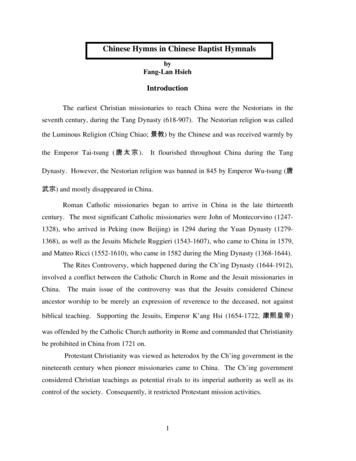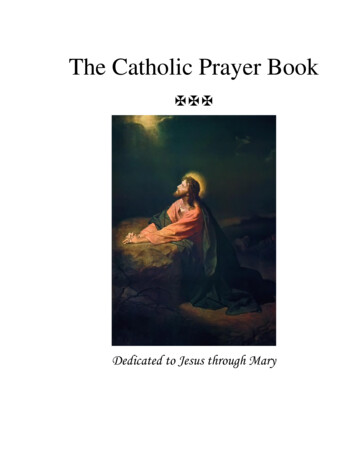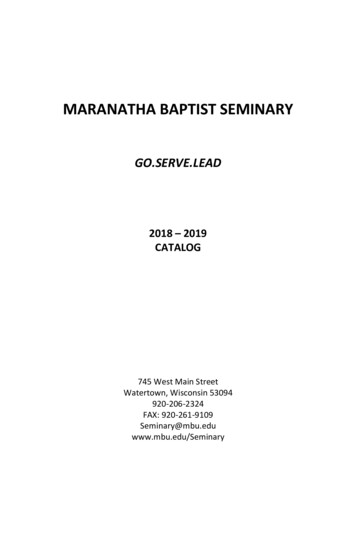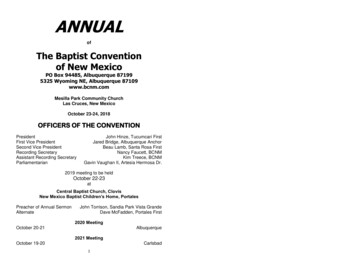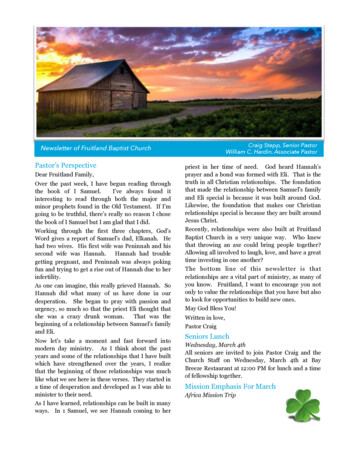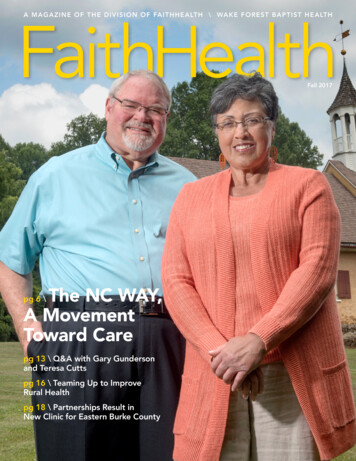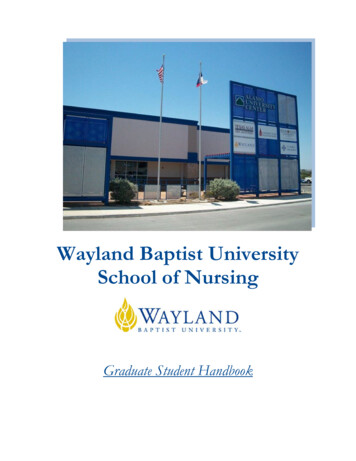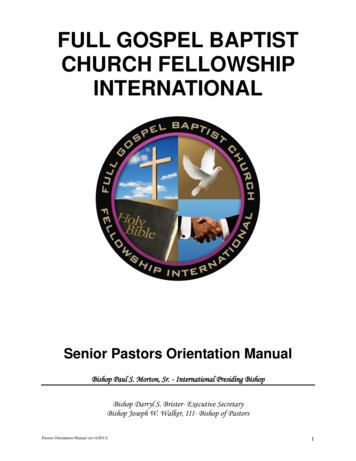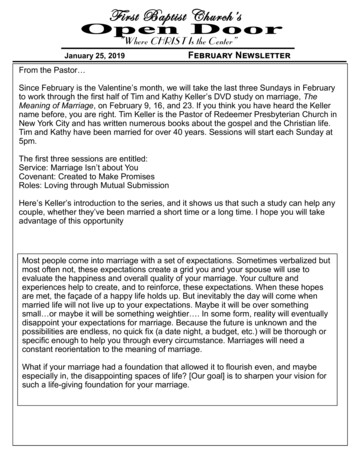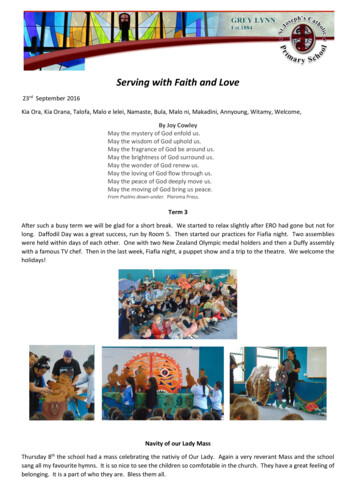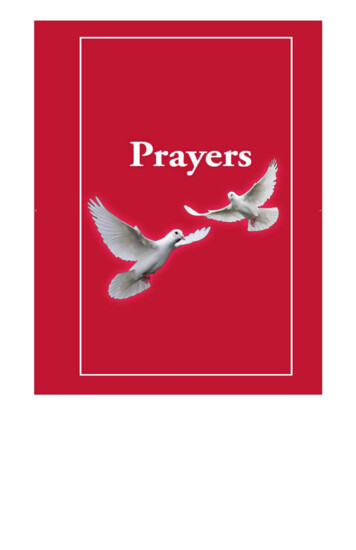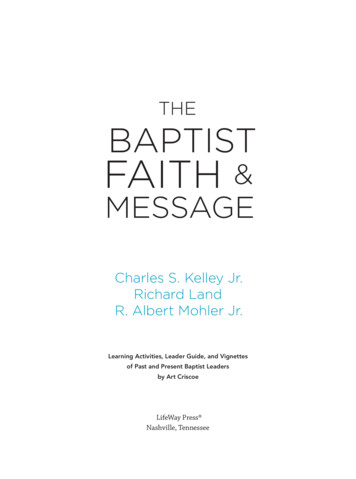
Transcription
THEBAPTISTFAITH &MESSAGECharles S. Kelley Jr.Richard LandR. Albert Mohler Jr.Learning Activities, Leader Guide, and Vignettesof Past and Present Baptist Leadersby Art CriscoeLifeWay Press Nashville, Tennessee
2007 LifeWay Press No part of this book may be reproduced or transmitted in any form or by any means, electronicor mechanical, including photocopying and recording, or by any information storage or retrievalsystem, except as may be expressly permitted in writing by the publisher. Requests for permissionshould be addressed in writing to LifeWay Press ; One LifeWay Plaza; Nashville, TN 37234-0175.ISBN 978-1-4158-5295-8Item 005035536This book is the resource for course CG-0149 in the subject areas Baptist Doctrine and BiblicalFoundations in the Christian Growth Study Plan.Dewey decimal classification: 230.6Subject heading: BAPTISTS—DOCTRINESUnless otherwise noted, Scripture quotations are taken from the Holman Christian StandardBible , copyright 1999, 2000, 2002, 2003 by Holman Bible Publishers. Used by permission.Scripture quotations marked NIV are from the Holy Bible, New International Version, copyright 1973, 1978, 1984 by International Bible Society. Scripture quotations marked NASB are takenfrom the New American Standard Bible , Copyright 1960, 1962, 1963, 1968, 1971, 1972, 1973,1975, 1977, 1995 by the Lockman Foundation. Used by permission. (www.lockman.org)We believe that the Bible has God for its author; salvation for its end; and truth, without anymixture of error, for its matter and that all Scripture is totally true and trustworthy. The 2000statement of The Baptist Faith and Message is our doctrinal guideline.To order additional copies of this resource, write to LifeWay Church Resources Customer Service;One LifeWay Plaza; Nashville, TN 37234-0113; phone toll free (800) 458-2772; fax order to (615)251-5933; e-mail orderentry@lifeway.com; order online at www.lifeway.com; or visit the LifeWayChristian Store serving you.Printed in the United States of AmericaLeadership and Adult PublishingLifeWay Church ResourcesOne LifeWay PlazaNashville, TN 37234-0175
CONTENTSThe Authors . . . . . . . . . . . . . . . . . . . . . . . . . . . . . . . . . . . . . . . . . . . . . . . . . .4Dedication . . . . . . . . . . . . . . . . . . . . . . . . . . . . . . . . . . . . . . . . . . . . . . . . . . .5Introduction . . . . . . . . . . . . . . . . . . . . . . . . . . . . . . . . . . . . . . . . . . . . . . . . . .5Chapter 1: The Scriptures . . . . . . . . . . . . . . . . . . . . . . . . . . . . . . . . . . . . . . .7Chapter 2: God . . . . . . . . . . . . . . . . . . . . . . . . . . . . . . . . . . . . . . . . . . . . . .21Chapter 3: God the Father . . . . . . . . . . . . . . . . . . . . . . . . . . . . . . . . . . . . . 31Chapter 4: God the Son . . . . . . . . . . . . . . . . . . . . . . . . . . . . . . . . . . . . . . .39Chapter 5: God the Holy Spirit . . . . . . . . . . . . . . . . . . . . . . . . . . . . . . . . . . 51Chapter 6: Man . . . . . . . . . . . . . . . . . . . . . . . . . . . . . . . . . . . . . . . . . . . . . .59Chapter 7: Salvation . . . . . . . . . . . . . . . . . . . . . . . . . . . . . . . . . . . . . . . . . .65Chapter 8: God’s Purpose of Grace . . . . . . . . . . . . . . . . . . . . . . . . . . . . . .77Chapter 9: The Church . . . . . . . . . . . . . . . . . . . . . . . . . . . . . . . . . . . . . . . .85Chapter 10: Baptism and the Lord’s Supper . . . . . . . . . . . . . . . . . . . . . . .93Chapter 11: The Lord’s Day . . . . . . . . . . . . . . . . . . . . . . . . . . . . . . . . . . . . 101Chapter 12: The Kingdom . . . . . . . . . . . . . . . . . . . . . . . . . . . . . . . . . . . . . 107Chapter 13: Last Things. . . . . . . . . . . . . . . . . . . . . . . . . . . . . . . . . . . . . . . 113Chapter 14: Evangelism and Missions . . . . . . . . . . . . . . . . . . . . . . . . . . . 121Chapter 15: Education. . . . . . . . . . . . . . . . . . . . . . . . . . . . . . . . . . . . . . . . 127Chapter 16: Stewardship . . . . . . . . . . . . . . . . . . . . . . . . . . . . . . . . . . . . . .135Chapter 17: Cooperation. . . . . . . . . . . . . . . . . . . . . . . . . . . . . . . . . . . . . . 141Chapter 18: The Christian and the Social Order . . . . . . . . . . . . . . . . . . . 147Chapter 19: Peace and War. . . . . . . . . . . . . . . . . . . . . . . . . . . . . . . . . . . .155Chapter 20: Religious Liberty . . . . . . . . . . . . . . . . . . . . . . . . . . . . . . . . . . 161Chapter 21: The Family . . . . . . . . . . . . . . . . . . . . . . . . . . . . . . . . . . . . . . . 167Notes . . . . . . . . . . . . . . . . . . . . . . . . . . . . . . . . . . . . . . . . . . . . . . . . . . . . .173Leader Guide . . . . . . . . . . . . . . . . . . . . . . . . . . . . . . . . . . . . . . . . . . . . . . . 177Christian Growth Study Plan . . . . . . . . . . . . . . . . . . . . . . . . . . . . . . . . . . .192
THE AUTHORSDr. Richard Land, the president of the Southern Baptist Ethics &Religious Liberty Commission, was named by Time in 2005 as oneof America’s 25 most influential evangelicals. Land has also writtennumerous books, including For Faith & Family, Imagine! A God-BlessedAmerica, Real Homeland Security, and The Divided States of America?Land also hosts two nationally syndicated radio programs, “ForFaith & Family” and “Richard Land Live!” (richardlandlive.com).Dr. Chuck Kelley, the president of New Orleans Baptist Theological Seminary, is recognized as a passionate evangelist, preacher,and church-growth researcher. He is the author of numerous articles, training materials, and books, including How Did They Do It?The Story of Southern Baptist Evangelism and The Roman Road tract,teacher guide, and learner guide.Dr. R. Albert Mohler Jr. is the president of the Southern BaptistTheological Seminary. He has been recognized by Time and Christianity Today as a leader among American evangelicals. Mohlerhosts a daily radio program for the Salem Radio Network. Hecomments on moral, cultural and theological issues through hisblog and online commentary. Mohler is also a contributor to OnFaith, an online conversation about religion, sponsored by theWashington Post and Newsweek magazine. These can be accessedthrough his Web site, www.albertmohler.com.The learning activities, leader guide, and vignettes of past and present Baptistleaders were written by Dr. Art Criscoe. Retired from LifeWay Christian Resources,Criscoe is a curriculum developer and writer for Christ to the World Ministries, aninternational missions organization. Criscoe has served as the pastor of churchesin Texas, South Carolina, and Tennessee and as an academic dean and a professorof Bible and Christian education at Columbia Bible College in South Carolina.4
DEDICATIONAdrian Rogers, 1931–2005Chairman, The Baptist Faith and Message Study Committee,1999–2000President, Southern Baptist Convention, 1979–80, 1986–88Adrian Rogers, denominational statesman, defender of the faith, beloved pastor,and prince among preachers is now in the presence of the Prince of Peace, havingheard, “Well done, good and faithful servant” (Matt. 25:21, NIV). The world—andnow heaven—will never be the same for his presence.INTRODUCTIONBaptists are a people of deep beliefs. From the very beginning of the Baptist movement, Baptist churches and associations of churches have adopted statements ofbelief to teach, defend, and perpetuate the faith “that was delivered to the saintsonce for all” (Jude 3). These statements, most commonly known as confessionsof faith, are intended to clarify and publish the most basic beliefs that frame ourfaith, our witness, and our worship. In the beginning years of the organized Baptistmovement, these statements were often intended to demonstrate that Baptistswere fully orthodox as Christian believers. Later, such statements were used toestablish identity, confront false teaching, and instruct Christians in the faith.The Southern Baptist Convention (SBC) first adopted a comprehensive statement of faith in 1925, when a committee led by E. Y. Mullins presented TheBaptist Faith and Message to the Convention. The statement was a revised editionof the New Hampshire Confession of Faith, then commonly used by Baptists inboth the North and the South.The 1925 committee brought its report during an era of controversy in Baptistlife. The fundamentalist/modernist controversy raged in northern denominations, and a growing climate of antisupernaturalism in the larger culture fueledSouthern Baptist concern. Another period of controversy emerged in the early1960s over the nature and authority of Scripture, and Southern Baptists revised5
The Baptist Faith and Message in 1963 at the recommendation of a committeeled by Herschel Hobbs.That committee revised the 1925 statement considerably, though it also explained,“In no case [have we] sought to delete from or to add to the basic contents of the1925 Statement.” The 1963 statement added new articles and revised the languageand content of the 1925 statement in significant areas. New concerns and emerging challenges led the Southern Baptists of that era to revise The Baptist Faith andMessage and to clarify our common beliefs.The SBC affirmed The Baptist Faith and Message in subsequent conventions, andin 1969 it adopted a motion encouraging the agencies, boards, and institutions ofthe Convention to use The Baptist Faith and Message as a guideline in employment,editorial content, and policy.The Baptist Faith and Message was next revised in 1998, when the SBC adopted“Article 18: The Family” at its meeting in Salt Lake City, Utah, in the midst of widespread societal concern about the breakdown of the family. The next year theSBC adopted a motion calling on the president of the Convention to appoint acommittee to review The Baptist Faith and Message and to bring a report and anyrecommendations to the Convention meeting the following year.1The Baptist Faith and Message Study Committee, with Adrian Rogers as thechairman, brought its report and recommendations to the SBC meeting in Orlando,Florida, in June 2000. During that meeting the Convention adopted the report,including a revised version of The Baptist Faith and Message.Looking back to the 1925 statement, Herschel Hobbs remarked, “This statement served in large measure to anchor Southern Baptists to their traditionaltheological moorings for a generation.” In reality, each new generation mustreclaim the priceless doctrinal heritage. At the dawn of a new millennium, TheBaptist Faith and Message now serves to anchor this generation of Baptists to thosesame theological moorings.We were honored to serve on The Baptist Faith and Message Study Committee,and we are honored to present this commentary to our fellow Southern Baptists.Our prayer is that God will lead this generation of Southern Baptists into a boldnew era of missions, evangelism, ministry, and vision and that God will bless ourwitness to His truth through The Baptist Faith and Message.1. Members of the committee included Max Barnett (OK), Steve Gaines (AL), Susie Hawkins (TX), Rudy A.Hernandez (TX), Charles S. Kelley Jr. (LA), Heather King (IN), Richard Land (TN), Fred Luter (LA), R. AlbertMohler Jr. (KY), T. C. Pinckney (VA), Nelson Price (GA), Adrian Rogers (chairman, TN), Roger Spradlin (CA),Simon Tsoi (AZ), and Jerry Vines (FL).6
CHAPTER 1THE SCRIPTURESArticle 1The Scriptures“The Holy Bible was written by men divinely inspired and is God’s revelation of Himself to man. It is a perfect treasure of divine instruction. It hasGod for its author, salvation for its end, and truth, without any mixtureof error, for its matter. Therefore, all Scripture is totally true and trustworthy. It reveals the principles by which God judges us, and thereforeis, and will remain to the end of the world, the true center of Christianunion, and the supreme standard by which all human conduct, creeds,and religious opinions should be tried. All Scripture is a testimony toChrist, who is Himself the focus of divine revelation.”1Memory Verses“All Scripture is inspired by God and is profitable forteaching, for rebuking, for correcting, for training inrighteousness, so that the man of God may be complete,equipped for every good work.” 2 Timothy 3:16-177
THE BAPTIST FAITH & MESSAGESouthern Baptists are known as a people of the Book. That Book isthe Bible. We come from all walks of life. With more than 16 millionmembers, our churches number more than 43,000 and dot the landscape. Spread from sea to sea, we are found in every state. Some ofus worship in small country churches, and some of us meet in largecity churches. Included in our number are churches that meet in huge,arena-type settings and churches that meet in portable buildings.Common to all of us, however, is our love for the Bible.God’s RevelationGeneral RevelationGod’s makingknown His natureand purposethrough natureand historySpecial RevelationGod’s makingknown His natureand purposethrough the writtenWord and His SonJesus ChristWhen we speak of the Bible or the Holy Scriptures, we are talkingabout 66 books divided into the Old and New Testaments. This Bookis different from any other book, for it is not a collection of humanopinions about God but is in fact God’s own Word. Baptists love andrespect the Bible as the Word of God.As God’s written revelation of Himself to humankind, the Bibleis one of God’s most precious gifts to us. In His written Word Godhas spoken to His people, taking the initiative to reveal Himself to usand to disclose Himself in a very real and understandable way. Without this divine self-disclosure we would have no certain knowledge ofGod, and all humanity would be left groping for answers in the dark.Each individual would have his or her own idea about God’s existence,character, and expectations of us. God’s revelation is a beautifuldemonstration of His love for us. He did not leave us in the dark.The Bible acknowledges that God has revealed Himself to allhumanity through creation itself. As the psalmist reminds us,The heavens declare the glory of God,and the sky proclaims the work of His hands.Psalm 19:1Every atom and molecule of creation reveals the wonder of God’smarvelous design. The intricate balance of creation, the beauty of theearth and its varied landscapes, the wonder of a sunset—all thesedeclare God’s greatness and glory. Beyond this, God reveals Himself toall persons through the moral faculty we call conscience. Our undeniable8
CHAPTER 1knowledge of good and evil, of right and wrong, points us to the perfectmoral character of our Creator. These types of revelation, which Godgave to all people who have ever lived, are called general revelation ornatural revelation. God’s revelation of Himself through the Bible andthrough His Son Jesus Christ is called special revelation.Identify each item as special revelation (S) or generalrevelation (G) by placing the correct letter in each blank.1. The beauty of creation 4. The Book of Isaiah2. The conscience within 5. Mountains, rivers3. The Bible6. John 3:16Read Romans 1:20 in the margin. Check below two thingswe can learn about God from what He has created. God’s love through Christ God’s divine nature God’s power of God The work of the Holy SpiritItems 1, 2, and 5 are general revelation, while 3, 4, and 6 are specialrevelation. God’s creation reveals His power and divine nature.If general revelation is available to all people, why do we need theBible? The Apostle Paul answered this question by explaining that oursin blinds us to a full understanding of God’s revelation of Himself innature and in our conscience. As he wrote to the Christians in Rome,human beings “exchanged the truth of God for a lie, and worshipedand served something created instead of the Creator” (Rom. 1:25).Our sin so distorts our spiritual vision that we love the lie and hate thetruth. God graciously provided humankind special revelation throughHis divine Word to teach us more about His nature, His redemptivepurpose, and His will for our lives.God for Its AuthorThe Bible is God’s revelation of Himself to humanity, and God isrightly known as the Author of all Scripture. Charles Haddon Spurgeon (1834–92), one of the greatest preachers in Christian history,said in a sermon in 1855, “This volume is the writing of the livingGod. everywhere I find God speaking: it is God’s voice, not man’s;9THE SCRIPTURESCHAPTERONETHESCRIPTURES“From the creationof the world Hisinvisible attributes,that is, His eternal power anddivine nature, havebeen clearly seen,being understoodthrough what Hehas made. As aresult, people arewithout excuse.”Romans 1:20
THE BAPTIST FAITH & MESSAGEInspirationThe breathing ofGod’s Spirit onhuman speech andwriting to producethe text of the Biblethe words are God’s words, the words of the Eternal, the Invisible,the Almighty, the Jehovah of this earth. This Bible is God’s Bible; andwhen I see it, I seem to hear a voice springing up from it, saying, ‘I amthe book of God: man, read me.’ ”2As The Baptist Faith and Message affirms, the Bible was written by men divinely inspired. What does this mean? We commonlyhear that a particular human author like William Shakespeare wasinspired. After an especially moving musical performance, someonemay remark that the composer or performer was inspired. Is the Bibleinspired in this same way?Of course not. If the Bible were merely a collection of particularly insightful writings about God, we would not stake our lives onits truth. Some have erroneously taught that the Bible is merely theproduct of an elevated human consciousness. Others have suggestedthat the Bible is unevenly inspired. Some parts, they argue, are moreinspired than other parts. This view places the human reader overScripture as judge, deciding what parts are most inspired and whatparts can be ignored or denied.Other people have argued that God merely inspired the ideascontained in the Bible, not the words of Scripture itself. This dynamictheory of the Bible’s inspiration holds that God gave the humanauthors basic ideas that they developed in their own ways. At theother extreme is the dictation theory, which sees the human authorsas passive instruments of the Holy Spirit’s inspiration, simply takingdown divine dictation for the record.Like today, more than one hundred years ago Baptists wereconfronted with such theories of biblical inspiration. Basil Manly Jr.(1825–92) was one of the four founding faculty members of the Southern Baptist Theological Seminary in 1859 and taught at the seminaryfor many years.3 Manly’s seminary colleagues asked him to respondto dangerous theories that were infecting some churches, seminaries,and denominations. After reviewing the false theories of inspiration,Manly summarized an understanding of the full inspiration of theScriptures with these words: “The Bible as a whole is the Word of God,so that in every part of Scripture there is both infallible truth anddivine authority.”4 This is the conclusion of the verbal plenary theory of10
CHAPTER 1the Bible’s inspiration. Put simply, this means that the Bible’s inspiration is verbal—extending to the very words themselves—and plenary,or full. Thus, we affirm that every word of the Bible is inspired and thatevery word is fully inspired.Match each theory of inspiration with its definitionby placing the correct letter in each blank.1. The dynamic theorya. The authors were2. The verbal plenary theorypassive instruments3. The dictation theorywho recordeddivine dictation.b. Every word ofthe Bible is fullyinspired.c. God gave humanauthors basic ideasthat they developedin their own ways.The answers are 1. c, 2. b, 3. a.We believe the verbal plenary theory expresses the way the Bibledescribes its own inspiration. The Bible’s word for its inspiration isGod-breathed (see 2 Tim. 3:16-17). The Holy Spirit breathed this Wordthrough human authors divinely chosen for this task. God used theirpersonalities, writing styles, and personal experiences to acco
Common to all of us, however, is our love for the Bible. God’s Revelation When we speak of the Bible or the Holy Scriptures, we are talking about 66 books divided into the Old and New Testaments. Th is Book is diff erent from any other book, for it is not a collection of human opinions a
